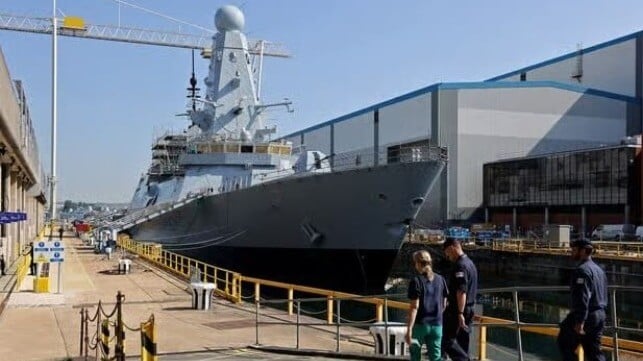UK Denies the Royal Navy Cannot Meet Operational Tasking

Information from multiple sources suggests that the Royal Navy is now unable to meet commitments in several important areas, contrary to UK Ministry of Defence insistence that it is continuing to meet its operational tasking. A pattern of over-reliance on allies for support in order to maintain basic operational capabilities is apparent in a number of areas. For political reasons the Ministry appears unwilling to acknowledge the difficulties. But the problems are now so widespread that the collapse in capability has become glaringly obvious, and all too embarrassing for friends and allies to mention.
The state of affairs is primarily a responsibility of British governments over many years who have shrunk the defense budget and delayed shipbuilding decisions, such that vessels are going out of service before new ships are delivered. At the same time, insufficient numbers of ships are being built to meet operational tasking, and the situation is compounded by a crisis in recruitment and retention. The issues are affecting operational capability across the whole fleet, and are not restricted to discreet capability areas.
In the Indo-Pacific, HMS Prince of Wales (R09) continues its long-range deployment. But the Royal Navy is only fielding two of its protective escorts, Type 45 destroyer HMS Dauntless (D33) and Type 23 frigate HMS Richmond (F239), the others being provided by a changing cast of ships from Norway, Spain, Canada, Australia and New Zealand. For half of its deployment, the Carrier Strike Group has relied on a Norwegian replenishment ship, the Royal Fleet Auxiliary being unable to field RFA Tidespring (A136) for the entire cruise. Meanwhile on deck, the carrier is only supporting two squadrons of F-35s, half the number it was designed to carry. Much smaller flattops, for example in the Italian Navy, carry similar numbers of aircraft.
Of six Type 45 destroyers, only two are operational, with HMS Daring (D32) about to return to service after a refit lasting over 3,000 days. The eight remaining Type 23 frigates are 30 years old, kept operational only with great difficulty, amongst them HMS Lancaster (F229), rumored likely to be withdrawn from Bahrain this year without replacement. The Type 23s are being replaced by Type 26s, with HMS Glasgow due in service in 2028, and Type 31s, with HMS Venturer due in service by 2027.
Even if there are no shipbuilding delays, in 2026 and 2027 the Royal Navy risks being down to less than five frigates, all of dubious serviceability. It is also possible that the Norwegian order for five Type 26 frigates announced on August 31 could delay delivery of some of the eight Type 26 frigates for the Royal Navy through the reallocation of production slots.
Underwater, delays in ordering new nuclear ballistic missile submarines mean that the Vanguard Class boats are suffering prolonged unserviceability. The need to always have one ‘bomber’ at sea has meant that three-month deployments are frequently extended, in one case in 2023 to six months. Prolonged deployments generate a whole series of problems, such as crew mental health and retention issues, and inevitably systems on board either fail or scheduled maintenance is missed, risky events in nuclear submarines. The consequences of running the Vanguard boats well beyond their design life will persist until at least the early 2030s, when new Dreadnought Class submarines currently being built start coming into service.
The situation with attack submarines is equally dire. The last Trafalgar Class submarine HMS Triumph (S93) was decommissioned in July. Of seven Astute Class submarines to be built, five are commissioned, but only one is believed to be operational, probably committed to protecting the on-station nuclear ballistic submarine at sea. None is available to counter the still-powerful Russian submarine force elsewhere, which probably explains why a recent Russian submarine alarm in the northern Norwegian Sea had to be covered at huge cost by P8 Poseidon aircraft instead.
In support of the fleet at sea, the Royal Fleet Auxiliary is suffering a manning crisis, and can probably only put four ships to sea.
The only healthy component of the fleet appears to be the offshore patrol vessels of the River Class, five of which are deployed to maintain the historic Royal Navy global presence, albeit with their limited firepower. The vessels cover for the shortage of destroyers and frigates - but without any anti-aircraft or anti-submarine capability. Royal Thai Navy versions of the same River Class design have a 76mm gun and Harpoon anti-ship missiles, Omani versions have a 76mm gun and Exocet missiles, but the Royal Navy ships for cost reasons only have a 30mm Bushmaster cannon.
For the next few years, until ships under construction come into service, Royal Navy planners will be praying that no operational emergencies arise - because so few ships are available to meet contingencies. It will be a struggle to maintain the underwater nuclear deterrent; there will be a single minesweeper in the Gulf to handle inevitable crises; issues generated by the wars in Gaza and Ukraine continue. But all the while, threats multiply and the seriousness of the lack of capability goes unrecognized.
The opinions expressed herein are the author's and not necessarily those of The Maritime Executive.
